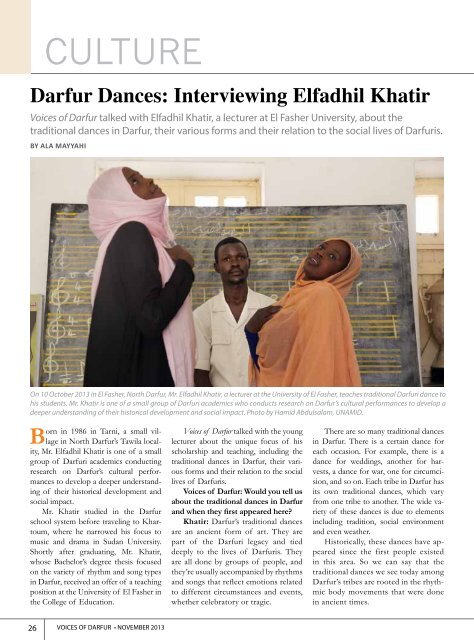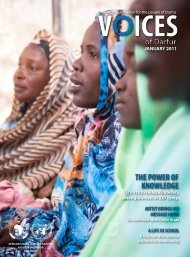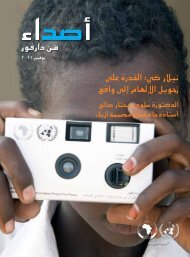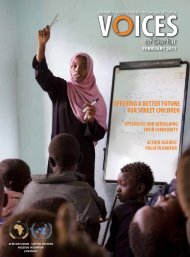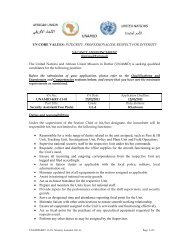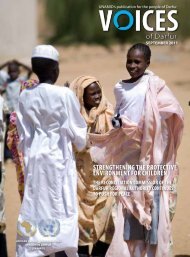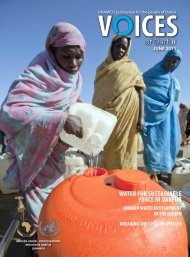Darfur Dances
Download the magazine (PDF) here. - Unamid
Download the magazine (PDF) here. - Unamid
- No tags were found...
You also want an ePaper? Increase the reach of your titles
YUMPU automatically turns print PDFs into web optimized ePapers that Google loves.
CULTURE<br />
<strong>Darfur</strong> <strong>Dances</strong>: Interviewing Elfadhil Khatir<br />
Voices of <strong>Darfur</strong> talked with Elfadhil Khatir, a lecturer at El Fasher University, about the<br />
traditional dances in <strong>Darfur</strong>, their various forms and their relation to the social lives of <strong>Darfur</strong>is.<br />
By Ala Mayyahi<br />
On 10 October 2013 in El Fasher, North <strong>Darfur</strong>, Mr. Elfadhil Khatir, a lecturer at the University of El Fasher, teaches traditional <strong>Darfur</strong>i dance to<br />
his students. Mr. Khatir is one of a small group of <strong>Darfur</strong>i academics who conducts research on <strong>Darfur</strong>’s cultural performances to develop a<br />
deeper understanding of their historical development and social impact. Photo by Hamid Abdulsalam, UNAMID.<br />
Born in 1986 in Tarni, a small village<br />
in North <strong>Darfur</strong>’s Tawila locality,<br />
Mr. Elfadhil Khatir is one of a small<br />
group of <strong>Darfur</strong>i academics conducting<br />
research on <strong>Darfur</strong>’s cultural performances<br />
to develop a deeper understanding<br />
of their historical development and<br />
social impact.<br />
Mr. Khatir studied in the <strong>Darfur</strong><br />
school system before traveling to Khartoum,<br />
where he narrowed his focus to<br />
music and drama in Sudan University.<br />
Shortly after graduating, Mr. Khatir,<br />
whose Bachelor’s degree thesis focused<br />
on the variety of rhythm and song types<br />
in <strong>Darfur</strong>, received an offer of a teaching<br />
position at the University of El Fasher in<br />
the College of Education.<br />
Voices of <strong>Darfur</strong> talked with the young<br />
lecturer about the unique focus of his<br />
scholarship and teaching, including the<br />
traditional dances in <strong>Darfur</strong>, their various<br />
forms and their relation to the social<br />
lives of <strong>Darfur</strong>is.<br />
Voices of <strong>Darfur</strong>: Would you tell us<br />
about the traditional dances in <strong>Darfur</strong><br />
and when they first appeared here?<br />
Khatir: <strong>Darfur</strong>’s traditional dances<br />
are an ancient form of art. They are<br />
part of the <strong>Darfur</strong>i legacy and tied<br />
deeply to the lives of <strong>Darfur</strong>is. They<br />
are all done by groups of people, and<br />
they’re usually accompanied by rhythms<br />
and songs that reflect emotions related<br />
to different circumstances and events,<br />
whether celebratory or tragic.<br />
There are so many traditional dances<br />
in <strong>Darfur</strong>. There is a certain dance for<br />
each occasion. For example, there is a<br />
dance for weddings, another for harvests,<br />
a dance for war, one for circumcision,<br />
and so on. Each tribe in <strong>Darfur</strong> has<br />
its own traditional dances, which vary<br />
from one tribe to another. The wide variety<br />
of these dances is due to elements<br />
including tradition, social environment<br />
and even weather.<br />
Historically, these dances have appeared<br />
since the first people existed<br />
in this area. So we can say that the<br />
traditional dances we see today among<br />
<strong>Darfur</strong>’s tribes are rooted in the rhythmic<br />
body movements that were done<br />
in ancient times.<br />
26 VOICES OF DARFUR • NOVEMBER 2013


